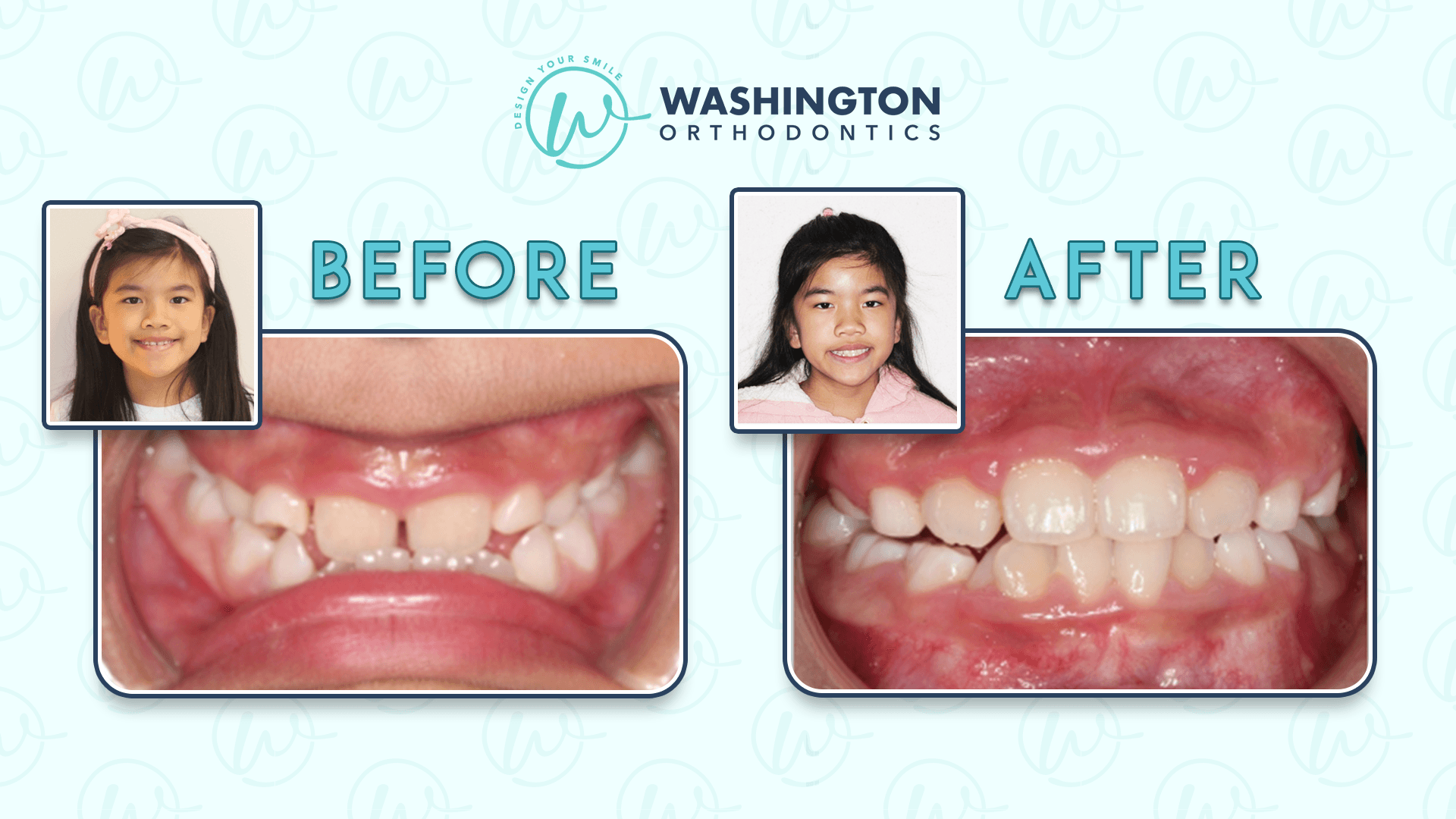Hearing that your child might need early orthodontic treatment can feel overwhelming. Parents often wonder if treatment is truly necessary or if it would be better to wait until all the adult teeth are in. No one wants to put their child through more than they need, and you want to make the most informed decision possible.
Early orthodontic treatment, also called Phase 1 orthodontics, focuses on guiding a child’s growing teeth and jaws while there is still a mix of baby and permanent teeth. It is not about creating a perfect smile right away. It is about building a healthy foundation so future treatment is easier and more predictable.
In this guide, we will walk through when early treatment makes sense, when simple monitoring is enough, and how our team at Washington Orthodontics helps families make confident choices. If you want a deeper look at the process itself, you can also review our main page on Phase 1 orthodontic treatment in Bellevue.
What Is Early Orthodontic Treatment?
Early orthodontic treatment usually takes place between ages 7 and 10, when a child still has some baby teeth and a few adult teeth. The focus at this stage is on how the jaws are growing, how the bite fits together, and whether there is enough space for adult teeth to come in.
Instead of straightening every tooth, Phase 1 treatment aims to guide growth, correct certain bite problems, and create room so that future treatment as a teen can be simpler and more efficient. The American Association of Orthodontists recommends that every child have an orthodontic checkup by age 7 for exactly this reason.
Phase 1 Treatment vs “Regular” Braces
Think of Phase 1 treatment as preparing the foundation. We address jaw position, bite issues, and serious crowding while your child is still growing. Later on, during Phase 2, we focus on detailed alignment and finishing touches once most or all of the adult teeth are in.
If you are curious about what full treatment looks like when your child is older, you can read more on our page about braces in Bellevue and Federal Way.
When Orthodontists Recommend Early Treatment
Not every child needs early orthodontic treatment. When we do recommend Phase 1 care, it is usually because we see issues that are much easier to correct while your child is still growing. Some of the most common reasons include:
- Significant crowding or lack of space for adult teeth to come in.
- Crossbites where upper teeth bite inside lower teeth.
- Underbites or overbites that affect jaw growth or function.
- Shifting or uneven jaw growth that makes the face or bite look off-center.
- Teeth that cannot erupt because there is not enough room.
- Habits like thumb sucking, extended pacifier use, or mouth breathing that are changing the bite.
When Monitoring Is Better Than Rushing Into Treatment
It is just as important to know when early treatment is not necessary. Many children who come in around age 7 simply need growth and development monitoring. That means we keep an eye on how their teeth and jaws change over time instead of starting treatment right away.
Monitoring may be the best choice when:
- Crowding is mild and may improve as more teeth come in.
- The bite is still developing and does not yet need correction.
- Your child is not quite ready emotionally, and treatment can safely wait.
As an orthodontic team, we would rather monitor a child who does not need treatment yet than rush into care before it is truly helpful. Our approach to Phase 1 orthodontic treatment always starts with an honest conversation about whether early care is needed or if careful observation is the better plan.
How We Decide If Early Treatment Is Necessary
Every recommendation we make is based on a detailed evaluation and a clear understanding of your child’s growth pattern. At Washington Orthodontics, we combine advanced diagnostics with simple, straightforward explanations so you always know why we suggest a certain path.
Comprehensive Evaluation and X-rays
During your child’s visit, we take photos, digital X-rays, and perform a thorough exam of their teeth and jaws. We look at how the upper and lower jaws fit together, whether there is enough space for adult teeth, and how the bite lines up front to back and side to side.
Talking Through Your Child’s Growth and Risk Factors
We also consider growth patterns, family history, and habits like thumb sucking or mouth breathing. Some children are at higher risk for crowding or jaw issues based on how their teeth and bones are developing. We will walk you through these factors in clear language and answer any questions you may have.
Presenting Options: Treat Now or Monitor
After we review the findings, we outline your options. Sometimes that means recommending Phase 1 treatment, along with what we hope to correct and how long it may take. Other times, we suggest monitoring and schedule periodic growth checks instead.
For additional context on how age plays into these decisions, you can review our guide on when you can get braces and age guidelines for kids, teens, and adults.
Phase 1 Treatment Before and After
It can be hard to picture what early orthodontic treatment actually does until you see it. That is why we like to share real before and after examples from children who have completed Phase 1 treatment at Washington Orthodontics. In many cases, you can see how crowded front teeth, crossbites, or narrow arches were improved while your child is still growing.
These photos show how guiding jaw growth and creating space early can set the stage for a healthier, more balanced smile before the teen years. Every child’s smile and treatment plan are unique, but these results give you a clear idea of what Phase 1 orthodontic treatment can accomplish.

If you would like to understand the full process behind these changes, you can start with our overview of Phase 1 orthodontic treatment in Bellevue or request an appointment to see what may be possible for your child.
What Happens If We Wait Too Long?
Parents are often told that it is better to wait until all the adult teeth are in, and in some cases that is true. The concern is not waiting a year or two. The greater risk is never having your child evaluated or delaying when a clear problem is already present.
When early treatment is strongly recommended but postponed for too long, it can be harder to correct certain issues. This may lead to:
- More complicated treatment later.
- A higher chance of needing extractions.
- Longer treatment times as a teen.
At the same time, one slightly late visit usually does not create major problems. If you are unsure, it is usually safer and easier to schedule an early orthodontic evaluation and then decide together whether Phase 1 treatment or monitoring is best. Our overview of Phase 1 orthodontic treatment in Bellevue explains how we approach these decisions step by step.
How Early Treatment Fits Into the Bigger Picture
One of the most common questions we hear is whether early treatment means “double treatment.” The short answer is no. Phase 1 and Phase 2 have different goals and often work together to create the best long-term result.
Phase 1 focuses on jaw growth, bite issues, and serious crowding while your child is still growing. Phase 2, usually during the early teen years, focuses on fine-tuning tooth positions with full braces or clear aligners once most of the adult teeth are in.
In many cases, children who complete Phase 1 find that their second phase is shorter, less complex, and easier to manage. If you are thinking ahead, our page on braces in Bellevue and Federal Way and our article on the cost of braces for kids can help you see how early care fits into the bigger picture.
Common Questions From Parents About Early Orthodontic Treatment
Is early orthodontic treatment always necessary?
No. Early orthodontic treatment is not always necessary. Many children are best served with regular growth and development monitoring and do not need Phase 1 care at all. We recommend early treatment only when it clearly helps prevent bigger problems or makes future treatment significantly easier.
How do I know if my child is a good candidate for Phase 1 treatment?
Children who have significant crowding, noticeable bite problems, jaw shifts, or habits that affect their bite are more likely to benefit from Phase 1 treatment. The best way to know for sure is to schedule an early evaluation so we can review your child’s specific situation and talk through the options. You can also learn more about the types of issues we treat on our Phase 1 orthodontic treatment in Bellevue page.
Will my child still need braces later if we do early treatment now?
Most children who receive Phase 1 treatment will still need some form of braces or aligners during their teen years. Phase 1 is about creating space, guiding growth, and correcting early bite issues, not finishing every detail. The benefit is that Phase 2 is often shorter, smoother, and more predictable because the foundation is already in place.
Is my child too young to handle braces or an expander?
Many children adapt to braces or an expander more quickly than their parents expect. We take time to explain everything in a kid-friendly way and give simple instructions they can follow with a little help at home. If we feel your child is not ready emotionally or practically, we will be honest about that and may recommend waiting and monitoring instead.
How much does early orthodontic treatment cost?
The cost of early orthodontic treatment varies based on what is needed and how long treatment will last. Phase 1 treatment is usually shorter and more focused than full treatment, and many families find that it helps make Phase 2 more manageable later on. For a detailed look at budgets, payment options, and planning, you can review our guide on the cost of braces for kids.
If you are curious about long-term benefits, you may also like our article on the benefits of braces for kids and how treatment can support your child’s confidence and oral health.
When to Schedule an Early Orthodontic Evaluation
The American Association of Orthodontists recommends that children see an orthodontist by age 7. That does not mean treatment will start at this age. It simply ensures that any growth or bite issues are caught early, and that you have a clear plan for the years ahead.
If your child is older than 7 and has never seen an orthodontist, it is still a good time to schedule a visit. It is almost never “too late” to get helpful information. At Washington Orthodontics, we care for families from Bellevue, Federal Way, and the surrounding communities, and we are committed to giving you honest guidance about whether early treatment or monitoring is best.
If you want to understand the full journey from early treatment through teen braces, you can start with our main overview of Phase 1 orthodontic treatment in Bellevue.
When you are ready, you can request an appointment and schedule an early orthodontic evaluation. We will review your child’s teeth, bite, and jaw growth, answer your questions, and help you decide the next best step for their smile.


